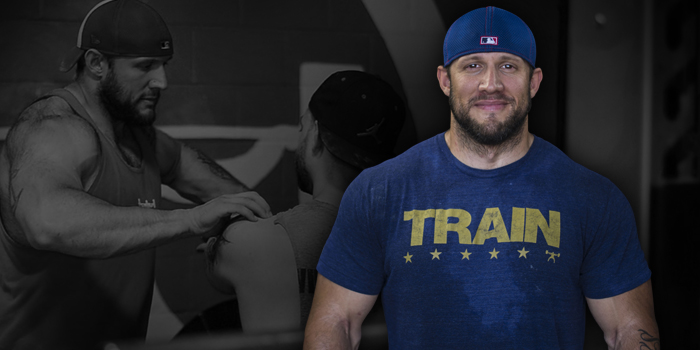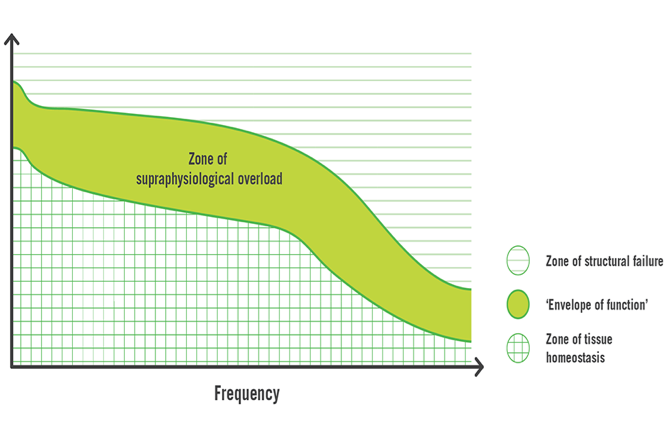
In training there are certain principals and concepts that are essential to making improvements and limiting setbacks. Progressive overload, super-compensation, and periodization are all essential to making strength gains. In the injury prevention and treatment field, the same notion applies. The article below will be an introduction to the dynamic relationship of tissue load and tissue capacity. It is important to understand this relationship, as it is essential for optimally recovering from injuries, minimizing the possibility of new injuries, and for properly re-introducing movements that are essential to your training but may have caused issues in the past.
RECENT: Revisiting Tonic and Phasic Muscles for Increased Performance and Position
Injuries occur for many reasons: shit form, poor mechanics, improper recovery, insufficient nutrition, etc. One of the most common causes is the accumulation of load on a tissue, tendon, or ligament exceeding that tissue, tendon, or ligament's capacity (when load is greater than capacity). Simply put, when this happens you have continued to work outside your body’s limits for too long.
Let’s establish a couple definitions first before we move into the nitty-gritty.
Tissue Load
This refers to any internal or external force produced on a muscle at any single point or at continuous points in times. Load can be expressed via total training volume, load intensity, load frequency, and load type (maximal, dynamic, repetitive).
Tissue Capacity
Tissue capacity refers to a tissue's ability to express tissue load through exercise, movement, or posture.
When looking at tissue capacity and its ability to handle load, there are different areas of training that become more important.
Frequency
When a tissue is loaded at a high frequency, its ability to recover is decreased unless the load is varied. Even when the load is varied, there still has to be ample time between stressors. Training at maximal effort followed immediately by training at dynamic effort the following day will still decrease the tissues capacity, despite the training differentiation. Even if the frequency is optimal and there is enough recovery time between sessions, repetitive use becomes the issue.
Repetitive Use
Performing an exercise repetitiously over a long period of time is essential for mastering technique. However, tissues do not have an infinite number of contractions. Regardless of the exercise itself, the joint, tissues, muscles, and fascia used all take on wear and tear. The only real way to prevent this from happening is to change the plane of motion in which they are used. This creates a different type of contraction and disperses the load differently to create less stress.
Posture
Posture and position directly affect tissue capacity. Whether the position or posture is dynamic or static is not relevant; what matters is if that position or posture is optimal or if it creates stress. This is referred to as a "negative postural position." Depending on the amount of time spent in this position, it can greatly push a tissues capacity to max.
 When the tissues cannot adapt to the stresses listed above, we often get a reactive response. This is usually expressed as swelling, tenderness, redness, inflammation, and pain. Unfortunately, these become norms and people try to push through these points, often negatively affecting the quality of their training and progression. Dye’s Envelope of Function (above) does a great job of expressing this. As expressed in the chart, there is an optimal envelope of function between load and capacity. As the load increases, the homeostasis of the tissue becomes disrupted and the tissue begins to fail. There is a sweet spot between load, capacity, and frequency. However, as the frequency continues, regardless of the severity of said frequency, tissue failure occurs.
When the tissues cannot adapt to the stresses listed above, we often get a reactive response. This is usually expressed as swelling, tenderness, redness, inflammation, and pain. Unfortunately, these become norms and people try to push through these points, often negatively affecting the quality of their training and progression. Dye’s Envelope of Function (above) does a great job of expressing this. As expressed in the chart, there is an optimal envelope of function between load and capacity. As the load increases, the homeostasis of the tissue becomes disrupted and the tissue begins to fail. There is a sweet spot between load, capacity, and frequency. However, as the frequency continues, regardless of the severity of said frequency, tissue failure occurs.
The tissue's capacity to accept load is dependent on multiple factors. Strength, movement and training age, tissue resiliency (flexibility), and other biomechanical factors all have roles. When looking at an injury, it is important to look at the entire kinetic chain and not solely at the injury site. This is important because, if we can identify which area is essential for the patient's rehab, we can then start to increase the load capacity globally. As a result, all the relevant tissues in the kinetic chain, including the local injured site, will begin to heal as well.
It takes a combined approach of modifying training variables and recovery to rebalance loading habits and tissue capacity. When the training load results in injury we can either reduce the load by modifying training volume or frequency, or we can increase the tissue's ability to manage that load through different strength training and conditioning variables. Regardless of the path chosen above, the rehab needs to be progressive. The load needs to meet the current demands of the tissue and the person being treated.
So, now that we have changed the tissue load by changing volume, frequency, repetitiveness, and posture, how do we increase tissue capacity to return to normal training? We'll cover this step in part two.










